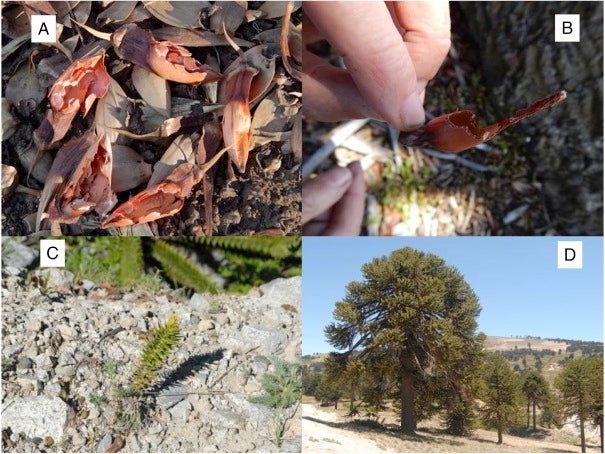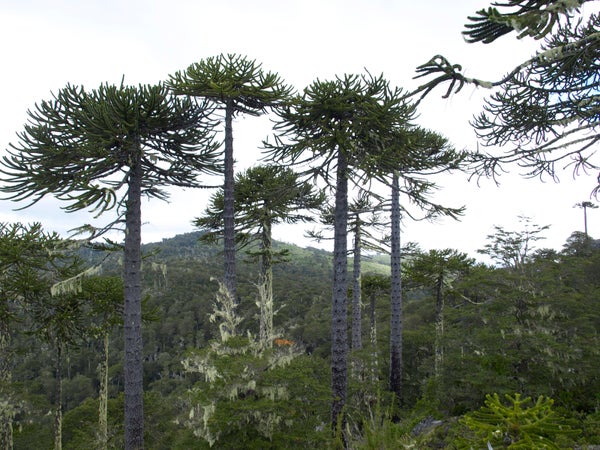This article was published in Scientific American’s former blog network and reflects the views of the author, not necessarily those of Scientific American
One of South America’s most striking tree species can grow to an amazing 40 meters in height and live for more than 1,200 years, but neither size nor age can help it survive from the effects of a long list of hungry invasive species.
The monkey puzzle tree (Araucaria araucana) grows in a restricted range of about 400 square kilometers within the Andes mountain range in Chile and Argentina. The trees have been there for millennia—they’re so-called “living fossils” and you’ll often see them in the background of artists’ depictions of dinosaurs—but they haven’t fared well in the modern world. Logging for the trees’ famously hard wood took a toll during the 20th Century, and in this century fires have taken down huge swaths of the trees that remained. Non-native trees and agriculture have also carved up the surrounding habitat. Oh, and humans have a tendency to over-collect the trees’ massive 3.5 gram seeds, which reportedly taste delicious when roasted.
Those threats, although bad enough, are just the tip of the iceberg. According to a paper published this month in Global Ecology and Conservation, monkey puzzle trees are now also threatened by not one, not two, not three but nine separate invasive species.
On supporting science journalism
If you're enjoying this article, consider supporting our award-winning journalism by subscribing. By purchasing a subscription you are helping to ensure the future of impactful stories about the discoveries and ideas shaping our world today.
You see, humans aren’t the only creatures that eat monkey puzzle tree seeds. Animals also love them. For centuries, Austral parakeets (Enicognathus ferrugineus) and four species of native mice have relied on the seeds for good portions of their diets. The seeds not only fed the native animals, the animals also helped to disperse the seeds away from their massive parents, giving any seedlings that survived a chance to grow and thrive.
Those five native species worked in conjunction with the monkey puzzle trees so that everyone benefitted. That age-old system is now out of whack. European settlers brought with them a wide range of new livestock species, inducing cattle, goats, horses, sheep, and pigs. For hunting purposes, they also imported wild boars (Sus scrofa), European hares (Lepus europaeus), European rabbits (Oryctolagus cuniculus), and red deer (Cervus elaphus). Many of those imports have now become invasive species.
And all nine of the species also love monkey puzzle tree seeds.
To study the effect of these invaders, a team of Spanish and Argentinian researchers visited 516 female monkey puzzle trees throughout their range. They found that at least 90 percent of the trees were visited by one or more exotic species to eat seeds. (The researchers could tell which species ate the seeds by the way seed coats had been opened or nibbled upon, or by finding partially digested seeds in feces.) The majority of trees had fewer than 10 uneaten seeds on the ground around them—a pretty low number when you consider that a single cone can contain 100 to 200 seeds.

Global Ecology and Conservation, used under a Creative Commons license
The cumulative effect of all of these extra hungry mouths, the authors wrote, is two-fold. For one thing, there are fewer seeds sitting on the ground year-round for native animals to eat. This interruption in their food cycle could cause their populations to decline.
For another, this leaves fewer seeds to actually end up in the ground. The authors reported that when two-to-four exotic species were present there was a resulting drastic reduction in young monkey puzzle tree seedlings. Those seedlings completely disappeared when the trees were visited by five or more exotic species. This lack of recruitment, quite obviously, could impact the long-term survival rates of this living fossil.
Of course, the authors note that if the invaders are properly managed (i.e., exterminated), then the trees could bounce back. They’re a long-lived species, after all, and the older the tree becomes the more seeds it produces. As long as the mature trees survive, the species probably will, too.
The parakeet and the native mice, however, could be a different story. They’re short-lived species and they also rely on a variety of other vegetation that live around the monkey puzzle trees. If the trees face many more rough years, will the entire ecosystem suffer as a result? Those questions have yet to be answered.
